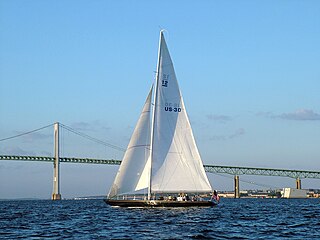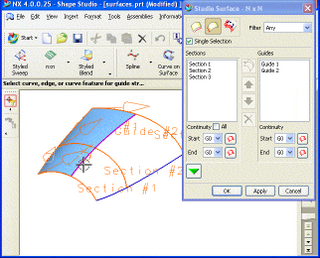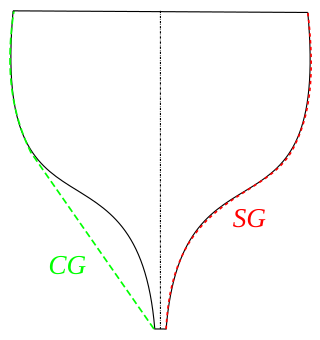
A kayak is a small, narrow human-powered watercraft typically propelled by means of a long, double-bladed paddle. The word kayak originates from the Greenlandic word qajaq.

In geometry, a polyhedron is a three-dimensional shape with flat polygonal faces, straight edges and sharp corners or vertices.

In geometry, the convex hull, convex envelope or convex closure of a shape is the smallest convex set that contains it. The convex hull may be defined either as the intersection of all convex sets containing a given subset of a Euclidean space, or equivalently as the set of all convex combinations of points in the subset. For a bounded subset of the plane, the convex hull may be visualized as the shape enclosed by a rubber band stretched around the subset.
Computational geometry is a branch of computer science devoted to the study of algorithms which can be stated in terms of geometry. Some purely geometrical problems arise out of the study of computational geometric algorithms, and such problems are also considered to be part of computational geometry. While modern computational geometry is a recent development, it is one of the oldest fields of computing with a history stretching back to antiquity.
Autodesk 3ds Max, formerly 3D Studio and 3D Studio Max, is a professional 3D computer graphics program for making 3D animations, models, games and images. It is developed and produced by Autodesk Media and Entertainment. It has modeling capabilities and a flexible plugin architecture and must be used on the Microsoft Windows platform. It is frequently used by video game developers, many TV commercial studios, and architectural visualization studios. It is also used for movie effects and movie pre-visualization. 3ds Max features shaders, dynamic simulation, particle systems, radiosity, normal map creation and rendering, global illumination, a customizable user interface, and its own scripting language.

In the design of experiments, optimal experimental designs are a class of experimental designs that are optimal with respect to some statistical criterion. The creation of this field of statistics has been credited to Danish statistician Kirstine Smith.

The 12 Metre class is a rating class for racing sailboats that are designed to the International rule. It enables fair competition between boats that rate in the class whilst retaining the freedom to experiment with the details of their designs. The designation "12 Metre" does not refer to any single measurement on the boat, and is not referencing the vessels overall length, rather, measures the sum of the components directed by the formula which governs design and construction parameters. Typically 12 Metre class boats range from 65 to 75 feet in length overall; they are most often sloop-rigged, with masts roughly 85 feet tall.

Freeform surface modelling is a technique for engineering freeform surfaces with a CAD or CAID system.

The International rule, also known as the Metre rule, was created for the measuring and rating of yachts to allow different designs of yacht to race together under a handicap system. Prior to the ratification of the International rule in 1907, countries raced yachts under their own national rules and international competition was always subject to various forms of subjective handicapping.

In mechanical engineering, a fillet is a rounding of an interior or exterior corner of a part designed in CAD. An interior or exterior corner, with an angle or type of bevel, is called a "chamfer". Fillet geometry, when on an interior corner is a line of concave function, whereas a fillet on an exterior corner is a line of convex function. Fillets commonly appear on welded, soldered, or brazed joints.

A ship must be designed to move efficiently through the water with a minimum of external force. For thousands of years ship designers and builders of sailing vessels used rules of thumb based on the midship-section area to size the sails for a given vessel. The hull form and sail plan for the clipper ships, for example, evolved from experience, not from theory. It was not until the advent of steam power and the construction of large iron ships in the mid-19th century that it became clear to ship owners and builders that a more rigorous approach was needed.
Geometry is a branch of mathematics concerned with questions of shape, size, relative position of figures, and the properties of space. Geometry is one of the oldest mathematical sciences.

The Apple Extended Keyboard is a computer keyboard that was first sold separately alongside the Macintosh II and SE starting in 1987. It was replaced in 1990 by the Apple Extended Keyboard II which was pre-packaged with Apple Professional Desktops starting with the Macintosh IIsi.

Chain girth is a measurement of a yacht hull.
A velocity prediction program (VPP) is a computer program which solves for the performance of a sailing yacht in various wind conditions by balancing hull and sail forces. VPPs are used by yacht designers, boat builders, model testers, sailors, sailmakers, also America's Cup teams, to predict the performance of a sailboat before it has been built or prior to major modifications.
Ton classes are categories used to identify classes of yachts.

The International Seven Metre Class is a construction class, meaning that the boats are not identical but are all designed to meet specific measurement formula, in this case International Rule. At their heyday, Metre Classes were the most important group of international yacht racing classes, and they are still actively raced around the world. "Seven" in class name does not, somewhat confusingly, refer to length of the boat, but product of the formula; 7 m boats are, on average, 13 meters long.

The International Ten Metre Class is a construction class, meaning that the boats are not identical but are all designed to meet specific measurement formula, in this case International Rule. At their heyday, Metre Classes were the most important group of international yacht racing classes, and they are still actively raced around the world. "Ten" in class name does not, somewhat confusingly, refer to length of the boat, but product of the formula; 10 Metre boats are, on average, 16.5 meters long.

The IYRU Fifteen Metre class yachts are constructed to the First International rule of 1907. A total of twenty 15mR yachts were built between 1907 and 1917, the four that have survived are still actively raced.














